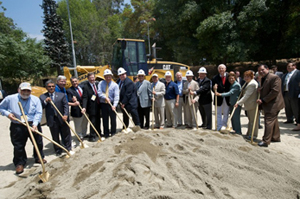Skanska USA Civil West and AECOM Technical Services were selected the design-build team on the first phase of the $810-million Metro Gold Line Foothill Extension project, which broke ground last weekend at a ceremony in Arcadia.


The first phase project is called the “Iconic” bridge. It will be a 740-ft-long structure over the southbound lanes of the Interstate 210 freeway. The Metro Gold Line Foothill Extension Construction Authority anticipates the project will provide 500 engineering and construction jobs.
There were two pre-qualified teams for the bridge project. The construction authority picked the Skanska/AECOM team and its $18.6 million bid over a team of Shimmick Construction and Biggs Cardosa, which bid $22.7 million. The authority budgeted the project at $24 million.
The Foothill Extension will take the current Gold Line from its terminus in Pasadena for 11.3 more miles to the Azusa/Glendora border. Officials are projecting a 2014 opening.
Many other public officials made similar promises to keep improving the area’s transit system. County Supervisor Mike Antonovich reminded the crowd at the groundbreaking that the second phase of the Foothill Extension — from Azusa to Montclair — remains a top priority for Metro for certain types of federal funding. “None of us will rest until this line goes to Ontario Airport,” says Rep. Adam Schiff, talking about a third phase of the extension that is under study.
The Metro Gold Line Foothill Extension is the first Measure R rail project to begin construction; in November 2008, Measure R was approved by a two-thirds majority, committing a projected $40 billion to traffic relief and transportation upgrades throughout Los Angeles County over the next 30 years.
The Foothill Extension will extend the Metro Gold Line from Pasadena west to Azusa, with a later link planned to Montclair. The Metro Gold line – now operating between East Los Angeles and Pasadena – is an integral part of the Metro Rail system, which today spans 79 mi of track crisscrossing Los Angeles County.
“The Foothill Extension will take pressure off the over-burdened 210 freeway,” says Ara Najarian, chairman of the county’s Metropolitan Transportation Authority. “It’s going to help with air quality – not just in the San Gabriel Valley but throughout the region. It’s going to create 7,000 jobs – 2,600 in construction alone. It will generate nearly $1 billion in business revenues and $40 million in tax revenues.”
Under Metro’s Long-Range Transportation Plan, the Foothill Extension was not scheduled for completion until 2017. However, a funding agreement between Metro and the Metro Gold Line Foothill Extension Construction Authority – the agency building the line – accelerated construction.
Last March the board of directors of the Metropolitan Transportation Authority voted unanimously to transfer up to $810 million in Measure R sales tax money and other funds to the Metro Gold Line Foothill Extension Construction Authority. Once complete, Metro will operate the line.
The light rail will follow the path of the former Atchison, Topeca and Santa Fe railroad, starting at the current Gold Line terminus at Sierra Madre Villa Station and continuing down the center of the I-210 to Santa Anita Avenue before turning south of the freeway and joining the path of the former rail line. Stations will be in Arcadia, Monrovia, Duarte, Irwindale and Azusa, which will have two stops. Hundreds of parking spaces are planned along the line.
Metro Rail will mark its 20th anniversary in July. It is already among the 10 largest rail systems in the U.S. carrying more than 300,000 weekday boarding passengers. It will almost double in size as light rail lines are extended through the Westside. There also will be a downtown regional connector linking the Metro Blue, Gold and Expo lines, an extension of the Metro Purple Line subway to Westwood, plus a rapid transit option that will connect the San Fernando Valley and Westside through the Sepulveda Pass along the I-405 freeway corridor, an extension of the Metro Orange Line busway to Chatsworth, Metrolink and bus service improvements.
In related news, the city of Monrovia is moving ahead with plans for a mixed-use development called Station Square, which would be built around the new Metro station. Apartments, office space and retail are planned. The city is looking for a public-private partnership for the project.

Post a comment to this article
Report Abusive Comment